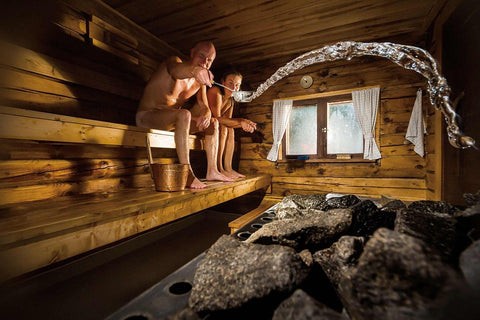The Best Guide To Traditional Sauna
The Best Guide To Traditional Sauna
Blog Article
Traditional Sauna Things To Know Before You Get This
Table of ContentsGet This Report about Traditional SaunaHow Traditional Sauna can Save You Time, Stress, and Money.The 45-Second Trick For Traditional SaunaTraditional Sauna Fundamentals Explained
A lot of the weight shed in a sauna is water loss and is re-gained upon rehydrating. Without a doubt sauna can be a vital part of a healthy and balanced weight loss program. To look at the differences in between typical and IR saunas, I will certainly divide these into verifiable, theoretical, and fabricated differences.Thus, the most popular factor in the saunawhich goes to the ceiling directly above the sauna heateris typically in between 185 and 190 F. Traditional Sauna. Claims that a traditional sauna surpasses 200 F is just not real and not suitable for electric saunas sold in the United States. The temperature for a far-infrared sauna is generally set between 120 and 140 F; nonetheless, unlike the traditional sauna, the goal in and IR room is not to achieve a heat
Because of this, the temperature difference is virtually unnecessary, considering that excessive sweating leads to both sauna types, but the technique of heating the body is different. In an IR sauna the bather will feel warm and will certainly sweat profusely, but at much reduced temperature levels. Thus, if the goal is to invest longer durations of time in the sauna, the IR sauna is an excellent selection.

8 Easy Facts About Traditional Sauna Explained
When the high temperature level is achieved, the elements cycle on and off to preserve the heat. The majority of conventional sauna users take pleasure in pouring water over the rocks to create heavy steam to raise sauna moisture degrees. The advantages of pouring water over the rocks consist of: making the room extra comfy, moistening the nasal flows, and permitting the use of aromatherapy by mixing vital oils with the water.
In a far-infrared sauna, the warm front penetrate the body to effectively heat up the body and elevate the body core temperature level. To attain this boosted temperature, Far-infrared emitters create infrared energy which is close to the same wavelength as that which the body naturally emitsoften referred to as the "Crucial Range" of 7 to 14 microns), so the power is well received by the body.
When the energy gets in the body, it triggers the body temperature level to boost and inevitably causes sweat. In an infrared sauna it is very important for the emitters/heaters to remain on practically constantly. Given that there is no mass of rocks to retain warm, the sauna will certainly cool down if the emitters closed off.
As discussed over, the sauna bather in an infrared room intends to position himself in front of operating emitters to get maximum take advantage of the warm. The heating time for the two areas can be very different, depending upon how the spaces are made use of. For a standard sauna, a bather needs to enable 30-40 mins for the room to attain a desired temperature and Full Article to properly pre-heat the rocks.
The 15-Second Trick For Traditional Sauna
A well created sauna will usually attain a temperature of 150-160 F in about 30-40 mins. For hotter temperature levels, the room may need to warm for a longer duration.
To some, 15 minutes was "lost" while the infrared power heated up the timber panels instead of heating up a body, while others find a pre-heated space to be much more comfortable and think a raised starting temperature level is additional reading essential to start perspiring. The length of advised use for each and every space is around the same (10-15 mins per session); nevertheless, because of the reduced air temperature levels and the capacity to really feel the results of infrared warmth much faster than a conventional sauna, it is not uncommon for a person to spend a total of 20-30 mins in an infrared sauna.
Conventional saunas have a tendency to be larger (thus make use of more electrical energy) than infrared saunas, although typical saunas are certainly available in one and 2 individual dimensions too. For a two-person typical sauna, 5x6 or 5x7 dimension is most preferred. The top bench can comfortably seat 2 or 3 individuals and is likewise enough time to relax throughout the sauna session.


The typical cost per kWH of power in the U.S. is approximately $0.11, so a 4.5 kW heating system will set you back roughly $.50 to run for one hour, if the heating system runs constantly for one hour. Usually a sauna heating unit will certainly run for 75% of the initial hour and 50% of subsequent hours on since the components cycle once the set temperature level is achieved.
Indicators on Traditional Sauna You Need To Know
A two person far-infrared area is typically literally smaller than a traditional sauna, frequently regarding 4' x 4' or smaller. The IR heater is usually 1.5-1.7 kW using a 120 volt 15 amp plug-in service. Given that the area can be utilized faster than a sauna area, we will think the space is made use of for to of an hour consisting of warm up time.
There is a rarely gone over see post distinction in the social experience in between the 2 areas. While our culture has lost a few of the social advantage of the traditional sauna experience, it can be extremely socially satisfying. From family members time in the sauna, to heart-felt conversations with loved ones, to sauna partiesthe typical sauna experience can cause intimate socializing.
Most greater end infrared spaces include tinted light treatment, noise systems and full-glass fronts.
Report this page